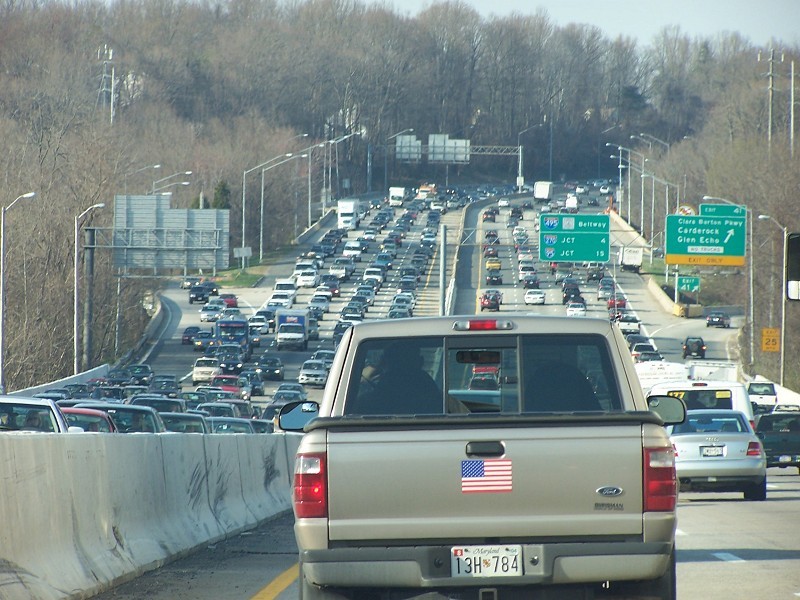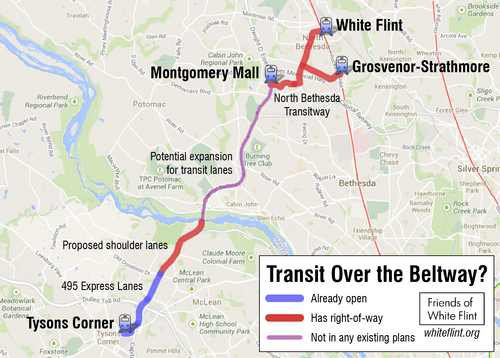The Outer Beltway won’t help the people it’s supposed to

Traffic on the American Legion Bridge. Image by BeyondDC licensed under Creative Commons.
Calls for an Outer Beltway, or a new ring road far outside the Capital Beltway, have begun anew with the area's Transportation Planning Board agreeing to study the issue. It's still a bad idea, because a new road won't actually help any of the drivers supporters say it will. In fact, it could make things even worse.
Montgomery County and Fairfax County have only one bridge crossing the Potomac River between them, the American Legion Bridge carrying the Capital Beltway downstream from Great Falls. It's often congested, and congestion is never fun. So people like to think that if there were another bridge and a new highway west of the Beltway, then maybe traffic wouldn't be so bad.
Potential routes for an Outer Beltway. Image by Piedmont Environmental Council used with permission.
That's the basic logic behind the Outer Beltway and a new Potomac River bridge: if there was a different route, then the people on the Legion Bridge would take the new bridge instead. But the observed phenomenon known as Induced Demand says that probably won't be the case. Rather, some people will peel off and take the new route, but more people will probably start driving because there's a new route.
Moreover, a lot of the people that are supposed to find new routes once a new bridge opens will simply continue taking the old bridge. That's because an Outer Beltway would actually be less convenient for these folks:
People driving through the DC area
One group that would purportedly benefit from a new highway is all the freight and through-traffic that's going around the DC area rather than somewhere in the region. Those travelers would definitely appreciate a faster trip.
Besides, the Beltway is the bypass for Washington, DC itself. At least that was the intent when it was built. But the area along the highway was built up, leading to more congestion, which led to widening, which led to more congestion, which led to more widening. Today, parts of the Beltway are 12 lanes wide, including the High Occupancy Toll (HOT) Lanes.
However, the actual number of through-travelers is actually really small. It turns out that 70% of the congestion you may encounter on the American Legion Bridge is local. And most of that local traffic is people going to work.
Commuters
If you're stuck in Beltway congestion every day trying to get to work, it might feel like there are a lot of people for whom the new bridge would cut down the distance of their commute. But again, that's only a small number of people. Just four percent of commuters who live in Fairfax County work in Montgomery County, and vice versa. And according to the Virginia Department of Transportation, most people using the American Legion Bridge to commute already live close to the Beltway, so there's no reason for them to take a different route.
A new bridge would certainly encourage more people to live and work in places that are farther apart, since the travel time would be lower. But there's induced demand in action again. Once everyone knows about the new route, that more people will change their habits to use it, which just creates more congestion.
Meanwhile, commuters who ride transit would lose out. Despite attempts in the past, right now there are no bus routes directly between Montgomery and Fairfax counties. An Outer Beltway bridge wouldn't help transit riders, because it wouldn't be close enough to where they live and work today, and if the Outer Beltway fills up with new traffic, transit routes there would suffer from the same congestion we have today.
The environment
Okay, so no one is exactly saying the Outer Beltway will help the environment, but supporters downplay the negative effects it would have. The biggest one would be the sheer amount of air pollution created by all the new driving. Moreover, it'd be putting air pollution in a number of environmentally sensitive areas.
One of those areas is Mather Gorge, the narrow section of the Potomac River home to Great Falls National Park. The American Legion Bridge is just east of the gorge, and any bridge would have to be built upstream. Except that would mean building a brand new highway through Montgomery County's Agricultural Reserve, which helps contain sprawl in rural areas while helping improve the region's air quality.
All of Virginia and Maryland
Any Outer Beltway bridge is going to connect counties in Virginia and Maryland. But that just means greater potential for a lose-lose situation. While Virginia's side of the river is more developed, an Outer Beltway would mean more pressure to just continue sprawling outward and promoting a driving-only transportation planning agenda, even as Northern Virginia is building the Silver Line to do the exact opposite.
Maryland, meanwhile, wouldn't just need to build a bridge (as the entire Potomac River belongs to Maryland) but also several miles of brand new highway to connect it to I-270, so the bridge wouldn't dump drivers onto rural roads. Whatever the cost of the bridge is, the highway miles needed to make up the difference would be even more.
So what can be done?
Congestion on the American Legion Bridge is a serious problem and opponents of a western crossing shouldn't just paint themselves as against solutions to easing congestion. We just need to go with ideas that can actually speed things up where they're already slow, instead of hoping that a new bridge will make old problems disappear.
Transit is one of them. It was tried before, but job centers in Tysons and Bethesda have grown since then, and the arrival of the Silver Line and other transit improvements in Tysons Corner may support more transit use. But even subsidizing a transit route for a long time until ridership can grow would still be far, far, cheaper than building a brand-new bridge and highway.
An even bigger idea would be to extend the proposed Purple Line from Bethesda across the river to Tysons. We already know locally how some transit lines do the equivalent work of entire highways when it comes to moving people across the river.
Potential options for transit on the American Legion Bridge. Image by Dan Reed.
High Occupancy Toll (HOT) lanes are another. There are already HOT lanes on the Virginia side that end just before the Legion Bridge, and I-270 has High Occupancy Vehicle (HOV) lanes that end at its interchange with the Beltway. Maryland and Virginia have talked about rebuilding the Legion Bridge, and including HOT lanes that could connect with new HOT Lanes on the Beltway and I-270. This plan may involve some widening, but at least the presence of tolls can stave off the negative effects of induced demand.
But land use might make the biggest difference. A lot of the region's job growth is concentrated in the western half of the region, which puts a strain on infrastructure in those areas and leaves the eastern half unable to reap the benefits. Regional strategies designed to add jobs and transportation in the eastern half of the region would help alleviate some of the congestion plaguing the American Legion Bridge and other roadways.
Even though I think an outer beltway is a bad solution, I do want to improve travel between Virginia and Maryland. But the bottom line is that a new bridge won't reduce congestion on the bridge we already have. It's to move on from this idea and embrace real solutions.
